Unlocking the Potential of AI to Increase Customer Retention
When artificial intelligence (AI) was introduced in the ’60s to mimic human decision-making, it was already heralded as the next big tech trend. Organizations were keen to adopt it even before they knew what it was or how it might apply to them. Fast forward six decades, and AI remains a hot topic, but we have only begun to scratch the surface of adoption. Many businesses claim to be using AI to improve processes, and more companies are including AI-powered capabilities in their offerings, but not all AI-based offerings deliver business value.
Recent research highlights the perfect opportunity for businesses to leverage AI to improve business processes. The findings reveal that the average customer turnover churn rate is now nearly one-third globally. This shocking statistic means companies are losing nearly one in every three customers. This has been identified as one of many challenges currently affecting businesses, alongside pandemic recovery, inflation, and other economic woes. This churn will be detrimental to business growth, revenue, and reputation without appropriate intervention.

Fortunately, 91 % of sales and marketing leaders plan to increase their deployment of AI-based technology to improve existing processes over the next two years. Successfully implementing AI can lead to better customer experiences, more personalized engagement, improved accuracy of forecast predictions, and better decision-making. These efforts will positively influence the bottom line.
Though many organizations recognize the potential of AI, the knowledge of how to unlock its potential is still not commonplace. To understand how to implement AI, businesses can work with a knowledgeable partner to help structure their data and processes, instill confidence, and help them achieve their desired results.
Not All AI Is Created Equal
Almost nine in ten (86 percent) leaders say their organization’s sales team is currently using AI to augment one or more of the following processes: automated emails; account intelligence; conversational AI; appointment setting; lead conversations; and opportunity to close predictions. These businesses are leveraging a patchwork of lightweight, often poorly integrated point solutions that often raise more questions than they answer, failing to help users prioritize their time and effort.
To be helpful, AI must provide more than just a score. Imagine scoring a lead a 79 versus another with a score of 73, based on propensity to close. These scores don’t explain the factors that make up that prediction; perhaps, more importantly, it does nothing to suggest ways for a seller to improve the likelihood of success. These kinds of challenges confuse users. Without help from an experienced partner, it can be difficult to achieve the benefits.
Organizations embracing AI need transparency as to what is being modeled, and conversely, the AI algorithms must consider what the users within those businesses wish to accomplish. For best results, a purpose-built AI that addresses the challenges directly is necessary. Integrating purpose-built AI doesn’t mean ditching Customer Relationship Management (CRM) data; instead, it involves transforming it into useful information that improves decision-making and predictability.
Breaking the Silos: Fusing AI and CRM
A true AI-fuelled CRM goes beyond simple automation. To provide real benefit, AI must aggregate data from multiple sources, including the need to break down organizational silos to identify patterns in interactions and offer deeper customer insights.
Some feel they don’t necessarily have enough primary data to build effective predictive models. Much organizational data is generated around a single customer or prospect. The trick is to leverage a CRM that understands and captures all of these interactions in a format that can fuel AI initiatives. Organizations will benefit from the most advanced predictive models by breaking down the silos between business units and integrating all of their valuable data.
This is often more challenging than it should be to implement. Business systems are typically good at providing a snapshot of an organization on any given day, but they aren’t usually as good at gathering historical information. This historical information is critical as it helps a business understand how it got to its current state and, more importantly, how to model the future for the greatest success.

There’s also the problem of reliability. User data is suspect, to begin with, and decays further over time. A well-founded AI data strategy will enrich and augment user-supplied data and facilitate automated data capture. These strategies will improve the resultant AI models, leading to better decision-making.
Finally, even when businesses are keen to collect data to improve the customer experience, they face global challenges from evolving privacy laws. These regulations, including the EU GDPR and the California Consumer Protection Act (CCPA), impact how companies must gather consent from users regarding how their data will be used.
Improving Retention with a Combination of the Old and New
An organization that has the complete picture of customers and leads, thanks to accessible data, can focus on leads that are most likely to convert and proactively anticipate and mitigate signs of customer churn. They can leverage all their business intelligence to focus their future lead generation activities—optimizing their sales and marketing pipelines.
AI vendors must build trust with users, make their solutions intuitive, and be transparent about their uses and limitations. Doing so will ensure that AI continues to evolve into the promised essential business tool, providing valuable insights and improved decision-making.
Technology is constantly evolving and maturing, and there are many potential opportunities. Blending CRM systems with AI technology will enable organizations to support end users in new and exciting ways, empowering them to improve satisfaction and drive customer retention.
This blog post is based on an article initially published in Information Age.



